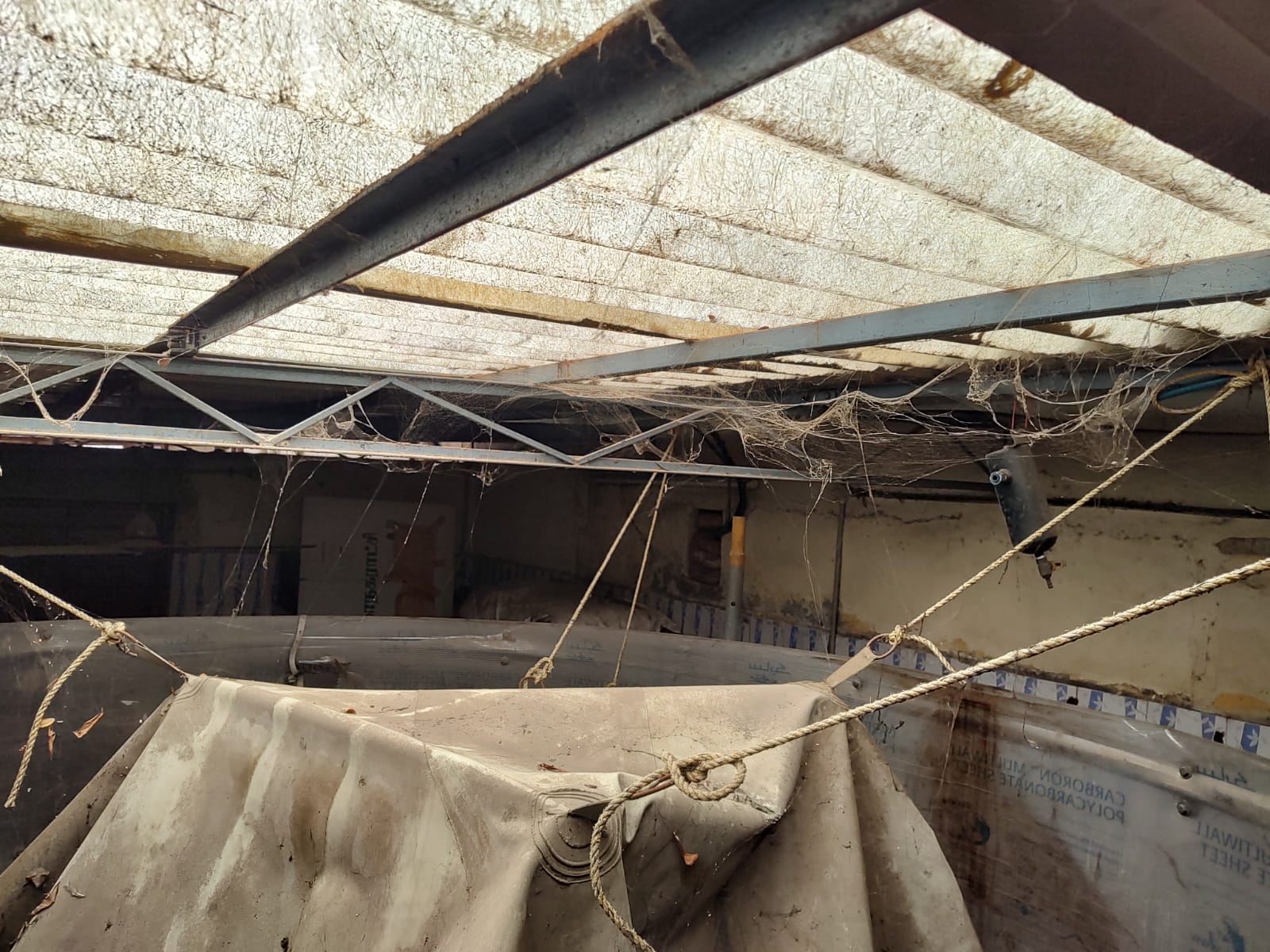Chennai's ambitious endeavor to bring green energy to Amma Canteens has become a colossal space-consuming dusty failure.
Published Aug 11, 2023 | 2:30 PM ⚊ Updated Aug 12, 2023 | 1:18 PM

Consuming space and catching cobwebs. A biomethanation plant at an Amma Canteen in Chennai. (Laasya Shekhar/ South First)
On Thursday, 10 August, the Amma Canteen on Taylors Road at Kilpauk in Chennai wore a deserted look by 10 am. The usual morning crowd of migrant workers had left after having their fill of either idli, sambar, and chutney for ₹1, or pongal for ₹5.
The middle-aged women running the outlet were still busy, packing off the remaining 60 idlis to cowherds and sending vegetable waste from the kitchen to landfills via the city’s conservancy workers. On days the cowherds failed to turn up, the idlis and other food remains would go to the landfills.
Today, they do not have the provision to treat the waste at source. Six years ago, the case was different. The canteen had a biomethanation plant that microbiologically converted organic waste into biogas and manure.
The eatery produces about 20-25 kg of food and kitchen waste a week. Besides preventing the improper disposal of filth, the biomethanation plant had earlier repurposed the waste into cooking gas.
Biomethanation plants created a green ecosystem as other neighbourhood hoteliers, too, utilised them. “There are not many cowherds around and these restaurants now dump food waste in the dustbins,” D Vendamathi, in charge of Amma Canteen at Taylors Road, told South First. The canteen caters to around 3,400 daily.
Today, biomethanation plants in Amma Canteens are space-consuming, dusty failures. South First visited six canteens across the city to understand the ground reality. Only three canteens boast of biomethanation plants — but all were out of commission.
According to the Greater Chennai Corporation (GCC)’s Solid Waste Management (SWM) Department, these plants were commissioned in different phases from 2014-15 to 2019-20. The plants were set up to minimise the canteens’ consumption of LPG, N Mahesan, Chief Engineer of SWM, said.
The plant served its purpose for less than a year. The workers could not fix the issues since they did not have the technical know-how.
A GCC official, who sought anonymity, said the project failed due to the absence of regular follow-ups by the civic body. “It has been many years since these biomethanation plants had stopped functioning. We should have either repaired these plants or cleared the space,” the official admitted to South First.
Each Amma Canteen, on average, produces about an average of 4 kg of waste a day. Going by the statistics, 393 canteens produce 1,572 kg of waste, which could be 120-150 units of power a day. A large proportion of organic waste is dumped in landfills resulting in the generation of methane — a pollutant and a potential fire hazard.
Women, who spend countless hours in the kitchen, found bio-CNG helpful. Unlike traditional energy resources such as LPG, bio-CNG generates flame without the intense heat.

Women enjoyed cooking in bio CNG as the renewable energy source generates flame but not heat. (Laasya Shekhar/ South First)
P Mary, who has been working at the Amma Canteen, Taylors Road, for 10 years, was more comfortable using bio-CNG. “It was easier earlier since unlike LPG, the flames did not hurt us,” she told South First.
The women at the Amma Canteen in Shenoy Nagar concurred. The plant here became defunct four years ago.
“We used to grind the waste in grinders provided for the process and dump the ground waste into the biomethanation plant. Even though the flame was heavy, we never felt the heat in the kitchen like we now do while using LPG,” V Devi, one of the employees, said.
Conservancy workers collect more than 5 kg of food waste the canteen generates daily.
Today, the grinders are used to store spoons, and biomethanation plants look like unused open wells.
Mangalam Balasubramaniam from Exnora Green Pammal, an organisation that provides maintenance services to biomethanation plants, emphasised the importance of understanding the science behind the process.
“The calorific value, fibre content, and the fat content of food waste all play a role in obtaining optimum methane levels required for biogas. Following a standardised blueprint for all canteens, without considering the varying characteristics of the food waste, has led to suboptimal results. Lack of training for workers and the absence of proper maintenance have also contributed to biomethanation-plant failure,” Balasubramaniam said.
Bhabha Atomic Research Centre (BARC) provided the technology for the biomethanation plants in Amma Canteens. A nuclear scientist told South First that the Chennai Corporation had approached BARC.
“The corporation has contacted BARC for the ‘Nisarguruna’ technology for managing biodegradable items, especially food waste from bulk generators such as hotels, restaurants, wedding halls, Corporation canteens, vegetable/fruit/flower markets, slaughterhouses, etc.”
The corporation, under the technical guidance of BARC, established three pilot biomethanation plants at Athipattu, Velangadu, and Ottery, each with a capacity of three tonnes per day. It had also set up two five-tonnes-per-day capacity plants at Pulianthope Perumbur slaughterhouse.
“The corporation is successfully operating them even about five years after they were commissioned,” said nuclear scientist Dr J Daniel Chellappa, associated with BARC. He added that the civic body could contact BARC to resolve any technical issues.
“The same technology of producing biogas from organic waste is being used in many municipalities in Tamil Nadu. In Chennai, the slaughterhouse waste from Perambur is not only processed into biogas but is also used to power the lights in the facility,” he added.
While the installation of biomethanation plants in Amma Canteens was a commendable move to promote clean energy and waste management, the lack of proper maintenance and understanding of the technology has rendered them useless.
Former chief minister J Jayalalithaa launched the Amma Canteens in February 2013, to cater to the needs of the poor. The DMK government that came to power in 2021, continued the scheme under the same name.
